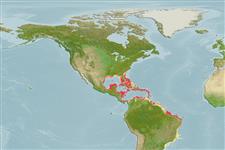Common names from other countries
Environment: milieu / climate zone / depth range / distribution range
Ecología
marino asociado a arrecife; rango de profundidad 10 - 40 m (Ref. 5222). Subtropical; 33°N - 29°S, 98°W - 33°W (Ref. 5222)
Western Atlantic: southern Florida (USA) and the Gulf of Mexico to Brazil. It was suggested that Mycteroperca tigris was a transient species in the northwestern Gulf of Mexico, but has recently become abundant on the Flower Garden Banks off Texas (Ref. 6887).
Length at first maturity / Tamaño / Peso / Age
Maturity: Lm 46.0, range 34 - ? cm
Max length : 101 cm TL macho / no sexado; (Ref. 26340); common length : 40.0 cm TL macho / no sexado; (Ref. 5217); peso máximo publicado: 10.0 kg (Ref. 5222)
Espinas dorsales (total) : 11; Radios blandos dorsales (total) : 15 - 17; Espinas anales: 3; Radios blandos anales: 11. Distinguished by the following characteristics: Back crossed by about 11 pale narrow lines that slope downward and forward. No other grouper in the Caribbean has the same pattern of narrow pale diagonal lines (Ref. 26938). Further characterized by having depth of body contained 3.1-3.6 times in SL; head length 2.5-2.8 times in SL; flat interorbital area; rounded preopercle, without lobe at angle; diameter of posterior nostrils 3-5 times larger than anterior ones; large teeth, well developed canines (Ref. 89707).
A solitary species (Ref. 26340) occurring in coral reefs and rocky areas. It is considered an ambush predator that hides among the coral and sponges and is easy to approach. Frequents cleaning stations (Ref. 9710). The size versus sex distribution of Bermuda population indicates that this species is a protogynous hermaphrodite; all fish less than 37 cm TL were females and all fish larger than 45 cm TL were males (Ref. 6886). Randall (Ref. 33) reported food of 59 specimens 15 to 57 cm SL were purely fishes of a variety of species.
Life cycle and mating behavior
Maturities | Reproducción | Spawnings | Egg(s) | Fecundities | Larva
Heemstra, P.C. and J.E. Randall, 1993. FAO Species Catalogue. Vol. 16. Groupers of the world (family Serranidae, subfamily Epinephelinae). An annotated and illustrated catalogue of the grouper, rockcod, hind, coral grouper and lyretail species known to date. Rome: FAO. FAO Fish. Synop. 125(16):382 p. (Ref. 5222)
IUCN Red List Status (Ref. 130435)
CITES (Ref. 128078)
Not Evaluated
Threat to humans
Reports of ciguatera poisoning (Ref. 30911)
Human uses
Pesquerías: comercial; Acuario: Acuarios públicos
Herramientas
Special reports
Download XML
Fuentes de Internet
Estimates based on models
Preferred temperature (Ref.
115969): 24.7 - 28, mean 27 (based on 148 cells).
Phylogenetic diversity index (Ref.
82804): PD
50 = 0.5000 [Uniqueness, from 0.5 = low to 2.0 = high].
Bayesian length-weight: a=0.01122 (0.00647 - 0.01946), b=3.05 (2.91 - 3.19), in cm Total Length, based on LWR estimates for this species & Genus-body shape (Ref.
93245).
Nivel trófico (Ref.
69278): 4.5 ±0.8 se; based on diet studies.
Resiliencia (Ref.
120179): Bajo, población duplicada en un tiempo mínimo de 4.5-14 años (K=0.11; tm=6.5-9.5).
Fishing Vulnerability (Ref.
59153): High vulnerability (64 of 100).
